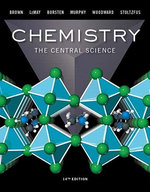?When the following reactions come to equilibrium, does the equilibrium mixture contain mostly reactants or mostly products? (a) \(\mathrm{N}_
Chapter 15, Problem 15.17(choose chapter or problem)
When the following reactions come to equilibrium, does the equilibrium mixture contain mostly reactants or mostly products?
(a) \(\mathrm{N}_{2}(g)+\mathrm{O}_{2}(g) \rightleftharpoons 2 \mathrm{NO}(g) \quad K_{c}=1.5 \times 10^{-10}\)
(b) \(2 \mathrm{SO}_{2}(g)+\mathrm{O}_{2}(g) \rightleftharpoons 2 \mathrm{SO}_{3}(g) \quad K_{p}=2.5 \times 10^{9}\)
Text Transcription:
N2(g) + O2(g) \rightleftharpoons 2 NO(g) K_c = 1.5 X 10-10
2 SO2(g) + O2(g) \rightleftharpoons 2 SO3(g) K_p = 2.5 X 109
Unfortunately, we don't have that question answered yet. But you can get it answered in just 5 hours by Logging in or Becoming a subscriber.
Becoming a subscriber
Or look for another answer
